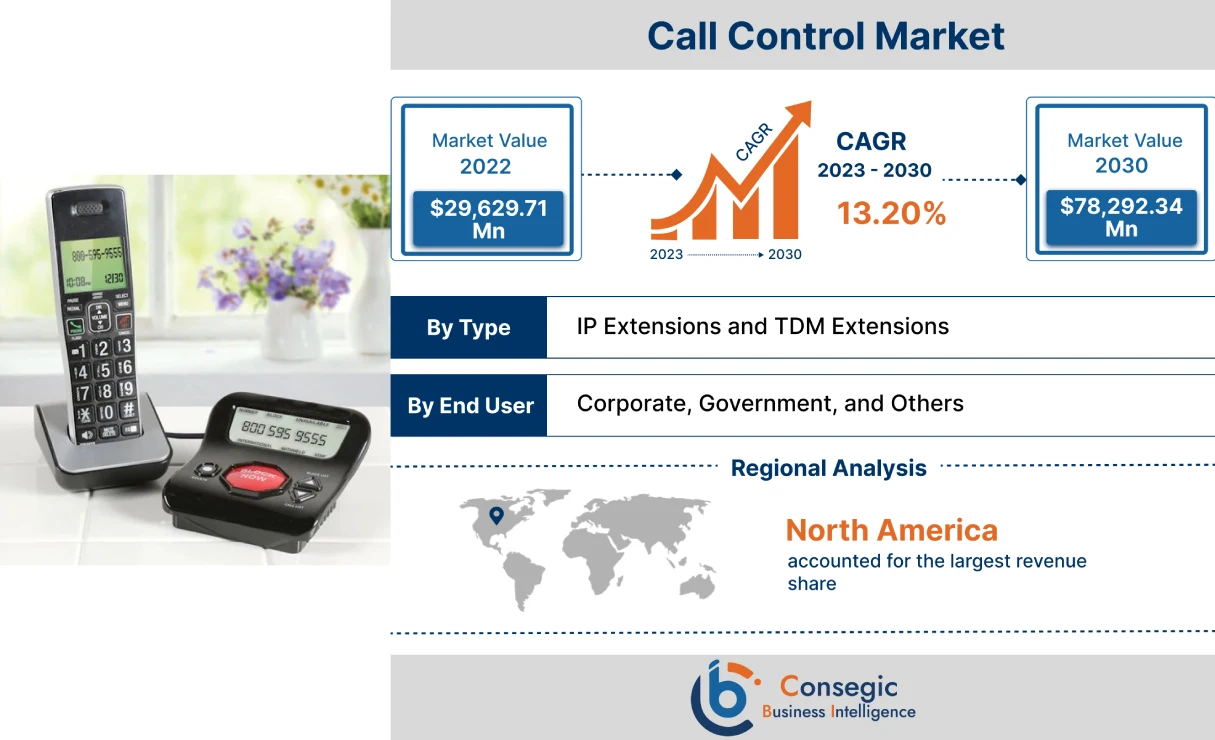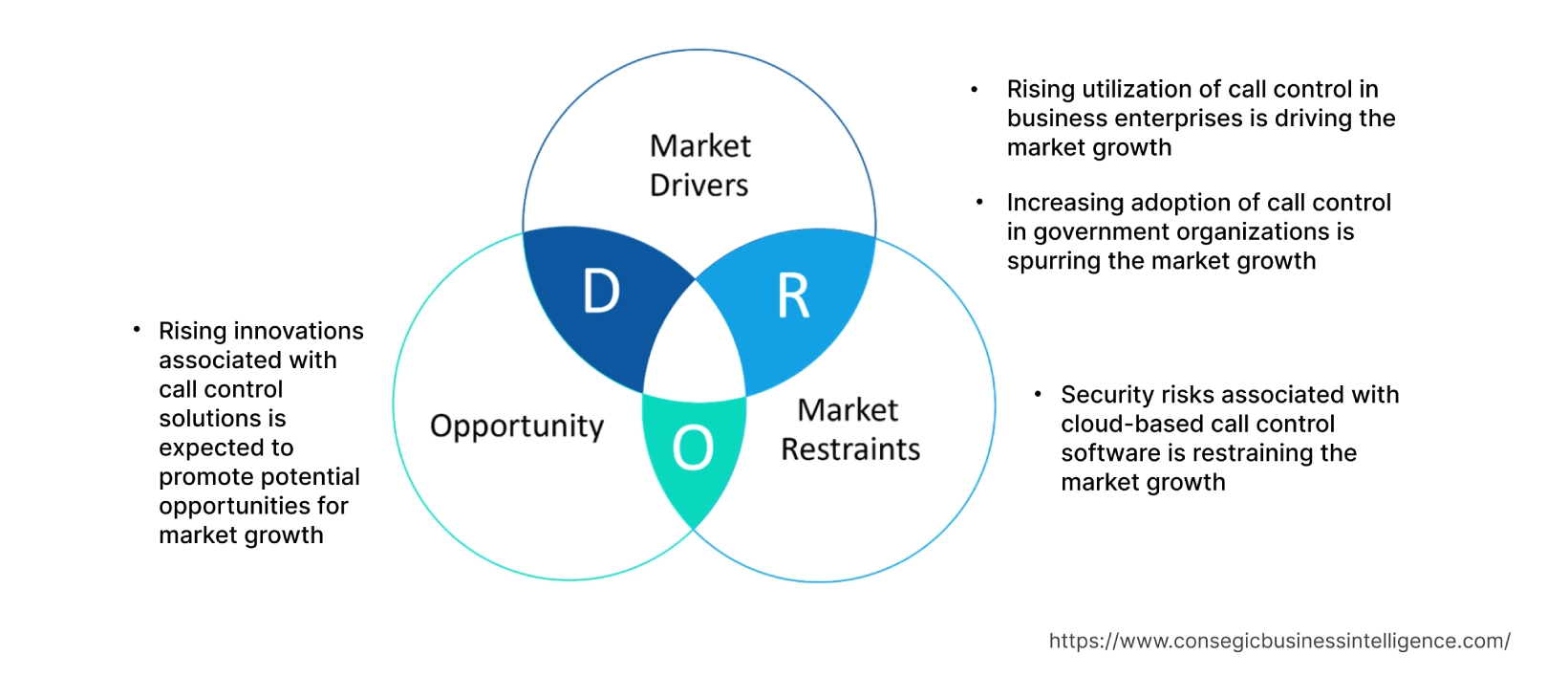- Summary
- Table Of Content
- Methodology
Call Control Market Size :
Call Control Market size is estimated to reach over USD 78,292.34 Million by 2030 from a value of USD 29,629.71 Million in 2022, growing at a CAGR of 13.20% from 2023 to 2030.
Call Control Market Scope & Overview:
Call control refers to a function in a business telephone switch or PBX that is capable of routing telephone calls to the proper destination. Moreover, call control is also capable of retaining the connection between two endpoints of a call and controls the connections within a voice over Internet Protocol (VoIP) system. Additionally, call control offers a range of features including call forwarding, muting, low-cost international calls, easy call routing configuration, and powerful auto-attendant features among others. The aforementioned benefits of call control are key determinants for increasing its deployment in corporate, government, and other sectors.
Call Control Market Insights :
Key Drivers :
Rising utilization of call control in business enterprises is driving the market growth
Call control is primarily utilized in business enterprises for call tracking tools, conversational AI and voice analytics programs, building contact center applications, and other related applications. Moreover, call control offers several benefits including flexibility, scalability, global audio conferencing, advanced text-to-speech, answering machine detection, and others. The above benefits of call control are key aspects for increasing its utilization in business enterprises.
Factors such as the rising pace of urbanization, increasing development of small & medium-sized business enterprises (SMEs), and the growing need for highly efficient communication solutions in business enterprises are key prospects driving the adoption of call control.
According to the Organization for Economic Co-operation and Development (OECD), there were more than 140 million SMEs (Small and Medium Enterprises) in China in 2020. Similarly, China registered around 2.52 million new corporate companies in 2020. Thus, the growing number of business enterprises is increasing the utilization of call control for facilitating advanced communication features and applications, in turn driving the growth of the market.
Increasing adoption of call control in government organizations is spurring the market growth
Call control is used in government organizations to regulate connections between two end-points that have already been established. Moreover, call control plays a crucial role in controlling various aspects of a call including call forwarding, call recording, dual channel call recording and long term storage, automated voice messaging, and others.
Factors including increasing expenditure in government & public sector, changing organizational structure, and incorporation of advanced communication technologies in the governmental organizations are among the primary aspects driving the market growth.
According to the Unacedemy, the number of public sector organizations in India increased to 365 as of March 2021, which includes 7 new defence PSU (Public Sector Undertakings). The public sector organizations in India represented a total investment of around USD 2.2 million in 2021. Hence, the growing number of government organizations is increasing the adoption of call control for unified and enhanced communication applications, in turn proliferating the market growth.
Key Restraints :
Security risks associated with cloud-based call control software is restraining the market growth
The implementation of cloud-based call control software is associated with data security risks, which is a prime factor restricting the growth of the market. The deployment of cloud-based call control software creates a higher risk of security threats including cyberattacks, data breaches, and privacy disclosures as most of the data including sensitive information is stored and processed on the cloud, which makes the system highly susceptible to cyber attackers and hackers.
Additionally, cloud-based delivery models are more prone to data loss or leakage, and accidental exposure of credentials, along with legal and regulatory compliance. Therefore, high data security risks associated with the implementation of cloud-based call control software are restraining the growth of the market.
Future Opportunities :
Rising innovations associated with call control solutions is expected to promote potential opportunities for market growth
Call control solution providers are constantly investing in the development of advanced call control features to ensure its efficient utilization in corporate and government enterprises among others. Hence, call control companies are launching upgraded solutions with new features and advancements, which is expected to promote opportunities for the growth of the call control market.
For instance, in October 2019, Telnyx LLC launched its new programmable call control API with updated features. Telnyx Call Control enables more customers to connect and control calls globally while providing more granularity. Moreover, primary features of the upgraded call control API include the ability to transfer or answer calls, record calls, play recorded messages, automatically detect answering machines, and other related features. Therefore, the rising innovations associated with call control solutions is anticipated to promote opportunities for market growth during the forecast period.
Call Control Market Report Insights :
| Report Attributes | Report Details |
| Study Timeline | 2017-2030 |
| Market Size in 2030 | USD 78,292.34 Million |
| CAGR (2023-2030) | 13.20% |
| By Type | IP Extensions and TDM Extensions |
| By End-User | Corporate, Government, and Others |
| By Region | North America, Europe, Asia-Pacific, Latin America, and Middle East & Africa |
| Key Players | Cisco Systems Inc., Avaya Inc., Telnyx LLC, NEC Corporation, Panasonic, Mitel Networks Corp, ALE International, Call Control LLC, Polycom LLC, TELUS |
Call Control Market Segmental Analysis :
By Type :
Based on the type, the market is bifurcated into IP extensions and TDM extensions. The IP extensions segment accounted for the largest revenue share in the year 2022. IP extensions is a type of PBX (Private Branch Exchange) system that utilizes Internet Protocol (IP) for call processing. IP extensions provide a cost-effective and efficient way of managing multiple telephone contacts within a single system. Moreover, IP call control systems offer several features such as call forwarding, caller ID, automated attendant, and others. The above features of IP extensions are increasing its application in corporate and government enterprises among others.
According to the Key 2021 Statistics for Singapore SMEs, the total number of enterprises in Singapore reached 291,600 in 2021, witnessing a growth of 6.8% as compared to 273,100 enterprises in 2019. Thus, the rising number of business enterprises is among the key factors driving the adoption of IP extensions for call control and processing, in turn contributing to the growth of the market.
The TDM extensions segment is anticipated to register fastest CAGR growth during the forecast period. TDM (Time Division Multiplexing) extensions enable users to make calls over an existing phone line. TDM extensions utilizes traditional telephone line technology for providing call control features such as call waiting, call forwarding, three-way calling, and other related features. Moreover, TDM extensions are ideal for businesses that require a high level of call control features.
For instance, according to SME Support Japan, there are approximately 3.58 million SMEs (small and medium enterprises) accountable for 99.7% of the total number of enterprises in Japan. Therefore, the growing corporate sector is anticipated to drive the market demand for call control solutions for fostering advanced communication features among corporate enterprises, in turn fueling the market growth during the forecast period.
By End-User :
Based on the end-user, the market is segregated into corporate, government, and others. The corporate segment accounted for the largest revenue share of 47.7% in the year 2022. Factors including the increasing development of business enterprises, rising adoption of remote and hybrid work cultures, and the growing need for highly efficient communication solutions in corporate offices are major factors driving the growth of the corporate segment.
For instance, according to the India Brand Equity Foundation (IBEF), the total number of small and medium enterprises in India witnessed a growth of 18.5% from 2019 to 2020. Therefore, the growth of corporate sector is increasing the utilization of call control solutions for facilitating advanced communication features and applications, in turn driving the growth of the market.
Government segment is expected to witness fastest CAGR growth during the forecast period. The growth of government segment is attributed to several factors including increasing expenditure in government & public sector, changing organizational structure, and incorporation of advanced communication technologies in the governmental organizations among others.
For instance, according to the Federal Register of the United States, there are approximately 435 government agencies operating across the United States as of 2023. Thus, the growing number of government organizations is increasing the adoption of call control solutions for unified and enhanced communication applications, in turn driving the growth of the market during the forecast period.
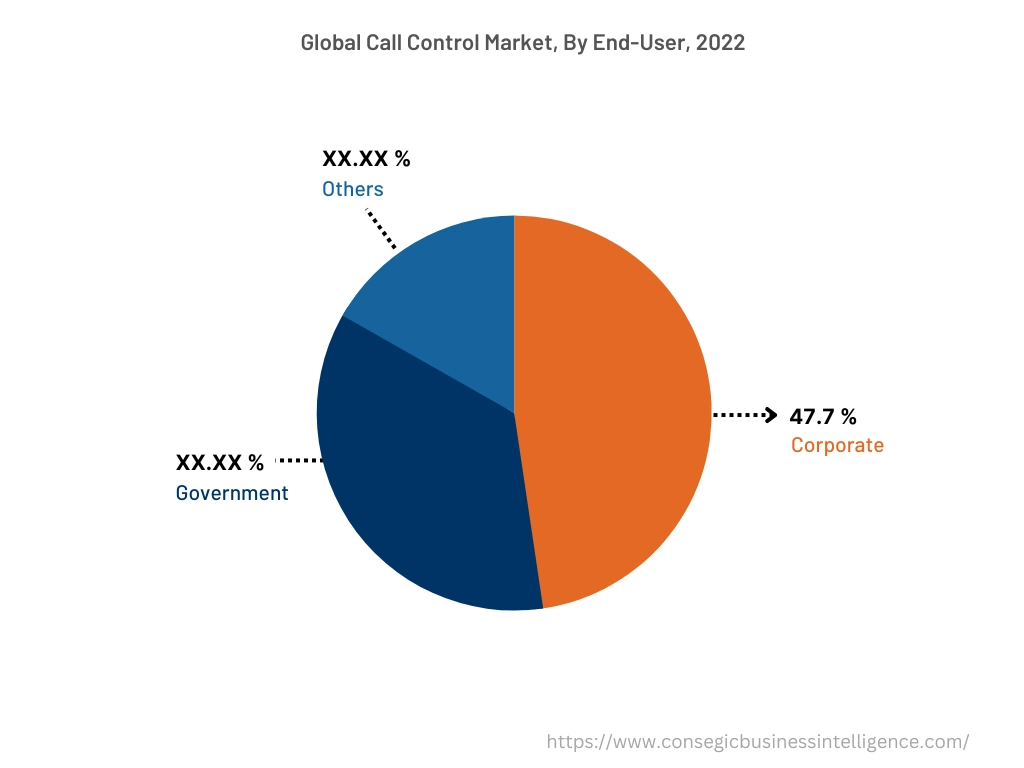
By Region :
The regional segment includes North America, Europe, Asia Pacific, Middle East and Africa, and Latin America.
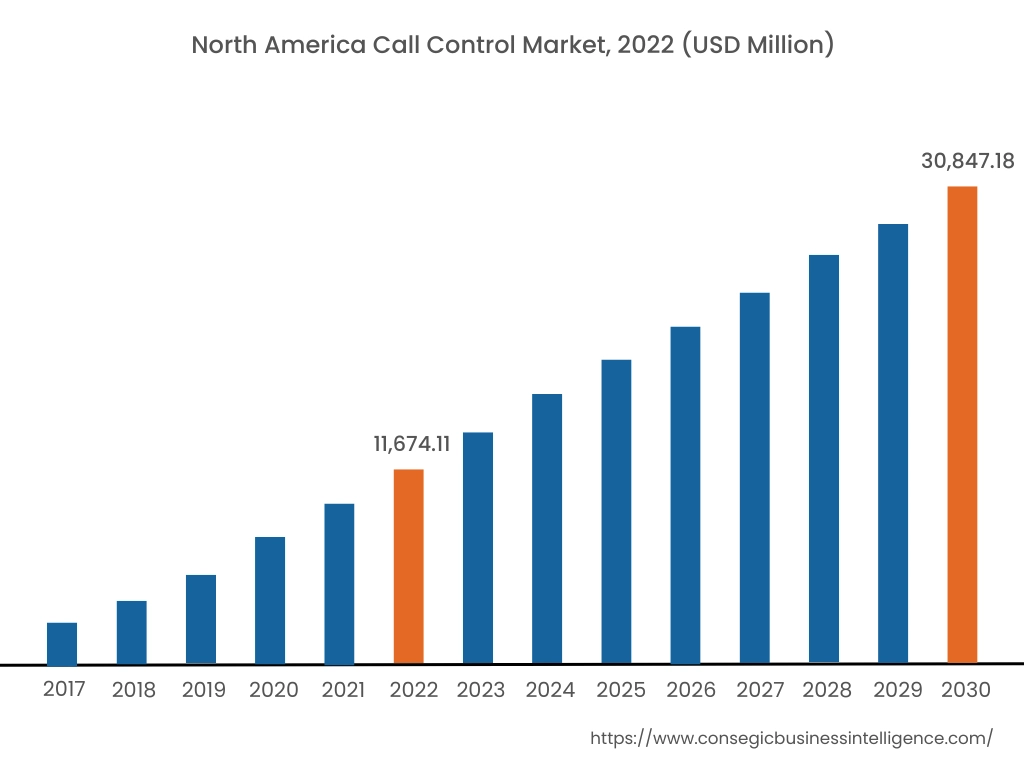
North America accounted for the largest revenue share of USD 11,674.11 Million in 2022 and is expected to reach USD 30,847.18 Million by 2030, registering a CAGR of 13.2% during the forecast period. In addition, in the region, the U.S. accounted for the maximum revenue share of 65.5% in the same year. The adoption of call control in the North American region is driven by several factors including the rising development of corporate offices and increasing demand for call control solutions from business enterprises in the region for facilitating advanced communication features and applications.
For instance, according to Oberlo, the number of small businesses in the United States reached 33.2 million in 2022, representing nearly 99% of total businesses in the U.S. Hence, the above factors are driving the adoption of call control solutions among business enterprises in North America, in turn driving the growth of the market in the region.
Asia-Pacific is expected to register fastest CAGR growth of 13.5% during the forecast period. The growing pace of urbanization and development is creating lucrative opportunities for the growth of the market in the Asia-Pacific region. Additionally, several factors such as the rise in large and small/medium enterprises, increasing investments in business enterprises, and the growing demand for efficient and scalable communication solutions are prime factors boosting the market growth in the Asia-Pacific region.
For instance, according to the India Brand Equity Foundation (IBEF), the budget allocation for small and medium enterprises in India in the financial year FY22 was valued at USD 2.14 billion, depicting a substantial increase from USD 1.03 billion in FY21. Thus, the growth of business enterprises is further driving the adoption of call control solutions for advanced and flexible communication applications, thereby driving market growth in the region during the forecast period.
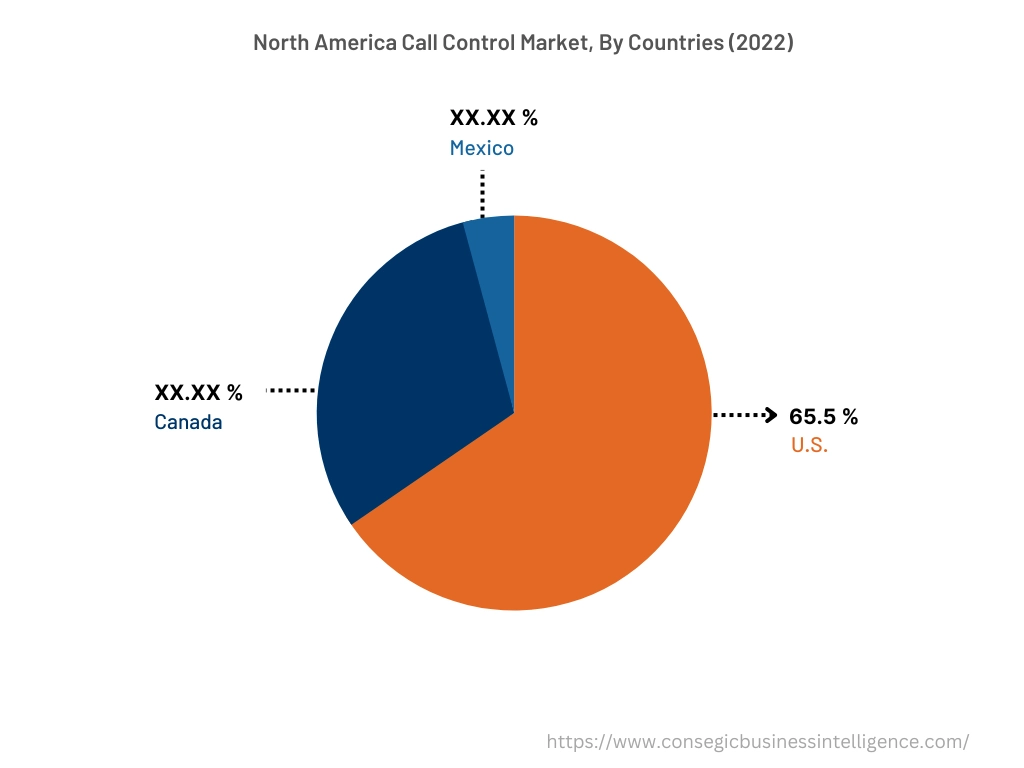
Top Key Players & Market Share Insights:
The call control market is highly competitive with major players providing call control to the national and international markets. Key players are adopting several strategies in research and development (R&D), product innovation, and application launches to hold a strong position in call control market. Key players in the call control market include-
- Cisco Systems Inc.
- Avaya Inc.
- Call Control LLC
- Polycom LLC
- TELUS
- Telnyx LLC
- NEC Corporation
- Panasonic
- Mitel Networks Corp
- ALE International
Recent Industry Developments :
- In October 2020, Avaya Inc. released its upgraded version of engagement call control. The new release fixed prior issues associated with REST services to utilize breeze A&A snap-in for all authentication and authorization.li>
Key Questions Answered in the Report
What is call control? +
Call control refers to a function in a business telephone switch or PBX that is capable of routing telephone calls to the proper destination.
What specific segmentation details are covered in the call control report, and how is the dominating segment impacting the market growth? +
For instance, by type segment has witnessed IP extensions as the dominating segment in the year 2022, owing to its increasing utilization in corporate and government enterprises among others.
What specific segmentation details are covered in the call control market report, and how is the fastest segment anticipated to impact the market growth? +
For instance, by end-user segment has witnessed government as the fastest-growing segment during the forecast period due to the rising adoption of call control solutions in government organizations for unified and enhanced communication applications.
Which region/country is anticipated to witness the highest CAGR during the forecast period, 2023-2030? +
Asia-Pacific is anticipated to register fastest CAGR growth of 13.5% during the forecast period due to rapid pace of urbanization, rising number of large and small/medium enterprises, and growing demand for efficient and scalable communication solutions.
